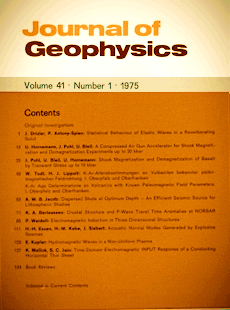An anomaly of the upper mantle below the Rhine Graben, studied by the inductive response of natural electromagnetic fields
Article Sidebar

Vols. 1-18 (1924-1944), ISSN 0044-2801
Main Article Content
Abstract
The methods of Magnetotellurics (MT) and Geomagnetic Deep Sounding (GOS) have been applied to study the electromagnetic response of the rift structure of the Rhine Graben. The measurements at 17 MT and 7 GOS stations were carried out along a profile running perpendicular across the Graben. Fourier analysis and numerical filters were tried for separation of the frequencies and a least squares technique was applied for data reduction. The thus gained transfer functions can be explained well by two-dimensional models under the following assumption: a well conducting layer at the depth between about 80 and 100 km exists at distances 50 km West and 100 km East of the Rhine Graben. Immediately below the Graben, however, a zone of similar good conductivity lies between about 25 and 45 km depth. The lateral extension of this zone is only some tens of km from the Graben's edges.
 ARK: https://n2t.net/ark:/88439/y032853
ARK: https://n2t.net/ark:/88439/y032853
Permalink: https://geophysicsjournal.com/article/276
Article Details
References
Berdichevsky, M.N., Van'yan, L.L., Fel'dman, I.S., Porstendorfer, G. (1972) Conductiong layers in the Earth's crust and upper mantle. Ger lands Beitr. Geophys. 71:187-196
Berktold, A. (1974) Erdmagnetische Tiefensondierung in Suddeutschland und in den Alpen. Protokoll DFG-Kolloquium Erdmagn. Tiefensondierung, Grafrath 11.-13.3.1974: Univ. Munich, pp. 58-70
Fournier, H., Adam, A., Miguel, L. de, Sanclement, E. (1971) Proposal for a first upper mantle magnetotelluric E-W profile across Europe. Acta Geodaet. Mont. Hung. 6:419-477
Haak, V. (1974) Berechnung von induzierten elektrischen und magnetischen Feldern in Modellen mit zwei-dimensional verteilter Leitfahigkeit. Protokoll DFG-Kolloquium Erdmagn. Tiefensondierung, Grafrath 11.-13.3.1974: Univ. Munich, pp. 400-428
Haak, V., Reitmayr, G. (1974) The distribution of electrical resistivity in the rhinegraben area as determined by telluric and magnetotelluric methods. In: Illies, J.H., Fuchs, K. (Ed.) Approaches to taphrogenesis, pp. 366-369. Schweitzerbart, Stuttgart
Haak, V., Sengpiel, K.-P., Berktold, A., Greinwald, S. (1970) The telluric method: Results of measurements along a profile across the rhinegraben between Stuttgart and Kaiserslautern. In: Illies, J.H., Mueller, St. (Ed.) Graben problems, pp. 235-238. Schweitzerbart, Stuttgart
Illies, J.H. (I967) Development and tectonic pattern of the rhinegraben. In: The rhinegraben progress report 1967. Abh. Geol. Landesamt Baden-Wurttemberg 6:7-9
Jones, F. W., Pascoe, L.J. (1971) A general computer program to determine the perturbation of alternating electric currents in a two-dimensional model of a region of uniform conductivity with an embedded inhomogeneity. Geophys. J. 24:3-30
Losecke, W. (1970) Ergebnisse magnetotellurischer Messungen bei Speyer. In: Illies, J.H., Mueller, St. (Ed.) Graben problems, pp. 242-244. Schweitzerbart, Stuttgart
Parkinson, W.D. (1959) Directions of rapid geomagnetic fluctations. Geophys. J. 2:1-14
Reitmayr, G. (1974) Elektromagnetische lnduktion im Erdinneren, studiert am Rheingraben. Diss. Geowiss. Fak. Univ. Munich
Scheelke, I. (1972) Magnetotellurische Messungen im Rheingraben und ihre Deutung mit zweidimensionalen Modellen. Gamma 20, Inst. Geophys. Meteorol. Tech. Univ. Braunschweig
Schmucker, U. (1970) Anomalies of geomagnetic variations in the Southwestern United States. Bull. Scripps Inst. Oceanogr. Univ. Calif. 13
Schmucker, U. (1971) Interpretation of induction anomalies above nonuniform surface layers. Geophysics 36:156-165
Schult, A. (1974) The electrical conductivity of minerals and the temperature distribution in the upper mantle. In: Illies, J.H., Fuchs, K. (Ed.) Approaches to taphrogenesis, pp. 376-378. Schweitzerbart, Stuttgart
Winter, R. (1973) Der Oberrheingraben als Anomalie der elektrischen Leitfahigkeit, untersucht mit Methoden der Erdmagnetischen Tiefensondierung. Diss. Math.-Naturwiss. Fak. Univ. Gottingen











